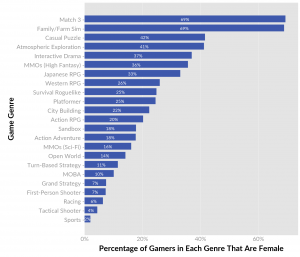First Person Shooters
First-Person Shooters are a genre of video game where the player’s character is seen through the first person perspective and centers on using shooting weapons to defeat enemies and advance through levels. These games typically use single or co-operative story modes, and in recent years have seen the expansion of multiplayer aspects, where a player can play against others online. Since their rise to popularity with the games Doom and Wolfenstein 3D, first-person shooters have become the most popular video game genre. This success on such a large scale has also brought ethical implications for first-person shooting video games, such as their focus on violence and their bias towards genders in game design.
Contents
History
While the earliest versions of first person shooting games can be accredited to the game Maze War and Spasim in the year 1974 [1], the main rise to popularity of the genre was coined with the games Wolfenstein and Doom [1]. These games were the first to employ modern graphics and mechanics and were followed by numerous other successful first-person shooting games near the end of the 1990s like Duke Nukem 3D, Quake, and Counter-Strike.While the earliest version of first-person shooters would be limited to PC, the expansion of the genre to console gaming opened an entirely new audience to first-person shooting games. Halo:Combat Evolved released in 2001, and displayed the powers of FPS games using the Xbox console. Halo’s success paved the groundwork for the development and focus of game companies of producing first-person shooters for console gaming, and the widespread success of the first-person shooting genre.
Online Multiplayer
The popularity of first-person shooting games saw a marked increase with the addition of online multiplayer modes. Services like Xbox Live expanded the market for simpler connections of players to an online service, as games before like Quake and Counter-Strike typically faced issues with slow connections and dial-up broadband services. Halo 3, a first-person shooter developed by Bungie, was able to use the online aspect of Xbox live to make their multiplayer mode be widely successful. The same year Call of Duty 4: Modern Warfare, released with similar success to its online mode. These games are coined with helping pioneer the online rise of first-person shooters and serving as a template for future first-person shooters with multiplayer options.
The addition and widespread use of multiplayer and online modes have also led to a rise in competitive gaming and E-sports, as players of first-person shooters became able to be played on a global scale.
Ethical Implications
Promotion of Violence
First-person shooters have faced criticism for their promotion of violence and other aggressive values. Critics of first-person shooters have cited that many mass shooters such as Adam Lanza, the Columbine shooters, and Cho Seung-Hui, were reported to have numerous hours spent playing violent first-person shooting games[2], often linking their behavior and these video games together. This link has brought to question whether these games can influence our identities and the values that we hold. First-person shooters then must be examined by their embedded values, which is the concept that a computer or technology system can "promote or demote particular moral values and norms"[3]. With this idea of embedded values applied to first-person shooters, the argument can be made that the consequence of playing violent first-person shooters promote values like violence and aggression, or promote disvaluing things like empathy. Evidence of these embedded values of first-person shooters can be seen being represented in studies, which have indicated that video game players often idolize the aggressive and violent traits of the protagonists of violent video games[4], or made players of violent games more emotionally desensitized[5]. It can also be seen that the act of shooting is a built-in consequence to first-person shooters and as a result makes them an aggressive genre of video games, as it is difficult to make the act of shooting with a weapon and rewarding "kills" or defeating enemies a non-violent or non-aggressive action [3].
Bias towards Genders
While first-person shooters may be the most popular video game genre, female players only make up 7% of the players of first-person shooters [6]. Such a drastic disparity in demographics has sparked questions as to why the first person shooter genre is so one-sided towards male players. However, nearly double this amount of women, 17%, have been recorded playing the game Overwatch[7], which has been accredited with its more gender-balanced design in mind that appeals to both men and women (yet still faces challenges and bias in its design). This change in the number of women playing exemplifies that it is in the design of these specific games that cater more to males than females. This bias in first-person shooters can first be attributed to the values of those designing them. In the game industry, women only make up 22% of the workforce[8]. As expressive values are defined as representing the values of the designers[3], then it follows that the male-dominated video game industry would create games that have drastic disparities in the representation of genders in their design compared to a more evenly distributed workforce. In one study of first-person shooters, for example, it was found that 19% of the games used a female avatar as the main playable character[9].To find what the implications of what this bias creates, one can look at the final game designs and the values within them. Utilizing the concept of embedded values as a lens to view what these games are promoting, it is apparent that first-person shooters often promote things like male protagonists, overly sexualized female character models, and reinforce gender stereotypes [3]. If these are the embedded values of the designs of first-person shooters then it should follow that the players of these games have their own values modified by playing them. Studies have revealed that playing violent shooting games decreases empathy of violence towards females and creates increased masculine beliefs in its players,[10]. This evidence of first-person shooters impacting a player's value system indicates that if left unaltered, the current state of these games will promote values of sexism, stereotyping, and bias in its players. As there are millions of players for first-person shooters, these embedded values then pose a threat to maintaining negative cultural sex roles and stereotypes of genders in the values of its players.
References
- ↑ 1.0 1.1 Staff, GamesRadar. “A 43-Year History of First-Person Shooters - from Maze War to Destiny 2.” Gamesradar, GamesRadar+ The Games, Movies and TV You Love, 1 May 2017, www.gamesradar.com/bullets-bombs-history-first-person-shooters/.
- ↑ Lindsay, Emma. “The Trouble with First Person Shooters Is Deeper than First Person Shooting.” Medium, Medium, 5 Mar. 2018, medium.com/@emmalindsay/the-trouble-with-first-person-shooters-is-deeper-than-first-person-shooting-157888e66807.
- ↑ 3.0 3.1 3.2 3.3 Brey, Phillip. “The Cambridge Handbook of Information and Computer Ethics.” The Cambridge Handbook of Information and Computer Ethics, by Luciano Floridi, Cambridge University Press, 2012, pp. 41–57.
- ↑ Konijn, Elly A., et al. “I Wish I Were a Warrior: The Role of Wishful Identification in the Effects of Violent Video Games on Aggression in Adolescent Boys.” Developmental Psychology, vol. 43, no. 4, 2007, pp. 1038–1044., doi:10.1037/0012-1649.43.4.1038.
- ↑ “Violent Games Emotionally Desensitizing.” Violent Games Emotionally Desensitizing - Universität Bonn, www.uni-bonn.de/Press-releases/violent-games-emotionally-desensitizing.
- ↑ Yee, Nick. “Beyond 50/50: Breaking Down The Percentage of Female Gamers By Genre.” Quantic Foundry, 14 June 2018, quanticfoundry.com/2017/01/19/female-gamers-by-genre/.
- ↑ McKeand, Kirk. “Twice the Number of Women Play Overwatch than Any Other FPS.” PCGamesN, www.pcgamesn.com/overwatch/overwatch-female-player-count.
- ↑ O'Brien, Lucy. “Women in Video Game Development in 2017: A Snapshot.” IGN, IGN, 20 Dec. 2017, www.ign.com/articles/2017/12/20/women-in-video-game-development-in-2017-a-snapshot.
- ↑ Hitchens, Michael. “Game Studies.” Game Studies - A Survey of First-Person Shooters and Their Avatars, gamestudies.org/1103/articles/michael_hitchens.
- ↑ Gabbiadini, Alessandro, et al. “Acting like a Tough Guy: Violent-Sexist Video Games, Identification with Game Characters, Masculine Beliefs, & Empathy for Female Violence Victims.” Plos One, vol. 11, no. 4, 2016, doi:10.1371/journal.pone.0152121.

